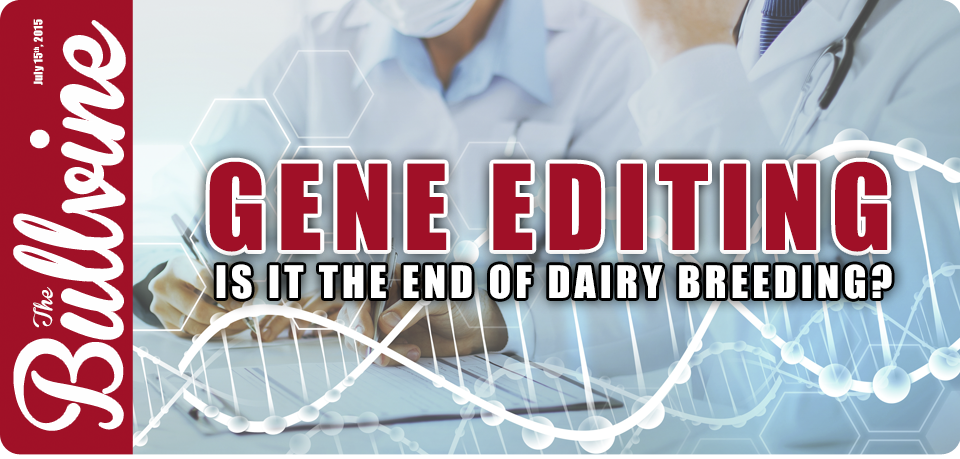For years, dairy farmers around the world have worked hard at developing and breeding a more desirable higher producing dairy cow. Now with the rapid developments in understanding the genomic structure and, even more recently gene editing, this process may become obsolete. Gene editing technology can accomplish immediately what would take the dairy breeding world 50 years.
First let’s get a couple points about gene editing clear. We are not talking about Frankenstein’s monster or transgenics, such as sheep that have mouse genes to grow wool faster, or goats that have spider genes making it possible for them to produce silk. Transgenetic experiments have been around for years and have never actually made it off the research farms. Consumer backlash and regulatory constraints to transgenetics have been tremendous deterrents. quoBounty Technologies, the company that made a fast growing transgenetic salmon, has spent 16 years and $70 million trying to get the fish cleared with regulators. Three years ago, after giving up hope of convincing regulators, the University of Guelph euthanized its herd of “enviropigs”, engineered with an E. coli gene, which meant they pooped less phosphorus.
Gene editing is different in that, instead of introducing traits from other species, gene editing is about using genes that already exist. An animal could be edited to possess the best traits their species has to offer. It may sound like just a slight change but from a consumer and a regulatory perception it could be significantly different.
We are not talking about fish that glow in the dark. We are talking about cows that are born polled, or Traits such as A2 Milk. Gene editing allows us to take the traits that already exist within a species and introduce them into the bloodlines that possess the most other desirable traits. This currently falls under a regulatory loophole. The FDA in the US current regulations on genetically engineered animals, issued in 2009, didn’t anticipate gene editing and does not cover it.
As we as an industry are gaining greater understanding of dairy cattle breeding at a genomic level, the question of being able to edit that data and paste the data we like from one genome to another is becoming a reality. With the knowledge of exactly what snippets produce the highest milk production or the most desired mammary systems, gene editing would allow us to marry those genetics into on animal faster than ever before.
Current genomic testing has shown us that a “Supercow” constructed from the best haplotypes in the Holstein population would have an EBV (NM$) of $6745. This is more than 5794 points higher than the current #1 NM$ sire Seagull-Bay Charismatic (951 NM$). At the present rate of genetic progress ($74 NM$ per year), it will take us 80 years to achieve the super genomic cow. With gene editing, that process could be cut down to 4 or 5 years!
Gene editing is a significantly faster and more precise method of genetic advancement than any other approach in the world today. While you may think this process is many years down the road, some major companies are already investing in it. One such case is Genus, the parent company to ABS Global. They have been funding some research by a business called Recombinetics and the research of Scott Fahrenkug. Recombinetics has been using a gene editing process called TALENs to snip segments of DNA representing undesirable traits such as horns and add other traits such as heat tolerance or higher production.
With these companies investing heavily into new technology, it raises the question of who owns the rights to the resulting information and products. Genomic testing showed us the advantage of an early access to information. Some had significant advantages in that scenario. Just think about what exclusive access to edited gene animals will have if it means a seven times greater genetic improvement over current options. If you think a 10% advantage is a game changer (aka the approximate advantage to early genomic information) think about what a 700% advantage would mean. Technologies like IVF and sexed semen have shown us the advantage that companies that own the patents on these technologies have.
With such significant advantage in the potential of the resulting animals, there really is no question that these genetics will be embraced by the dairy industry. One need only look at the corn and seed industries for examples. Approximately 80% of the world’s soy and cotton production is GMO. Corn currently stands at 35% and significantly higher (approx. 80%) in developed production countries that allow the us of GMO products. This mass adoption of GMO technology, despite consumer backlash, demonstrates that with significant improvements, GMO products are here to stay.
Bullvine Bottom Line
In 50 years the world population will require 100% more food and 70% of this food must come from efficiency-improving technology. Unless someone discovers how to dairy on the moon, we are going to have to become significantly more efficient in our milk production methods. Gene editing offers the potential to meet this demands. Current genetic advancement rates will be hard pressed to meet in 50 years what gene editing can offer in under ten years’ time. Sure a small number of very vocal consumers will be opposed to gene editing, but the masses want cheap, safe milk. Gene editing, since it is not transgenics, offers this possibility. This raises the question, “Are the dairy breeders of the future actually scientists sitting in labs?”
Get original “Bullvine” content sent straight to your email inbox for free.





















Leave a Reply
You must be logged in to post a comment.